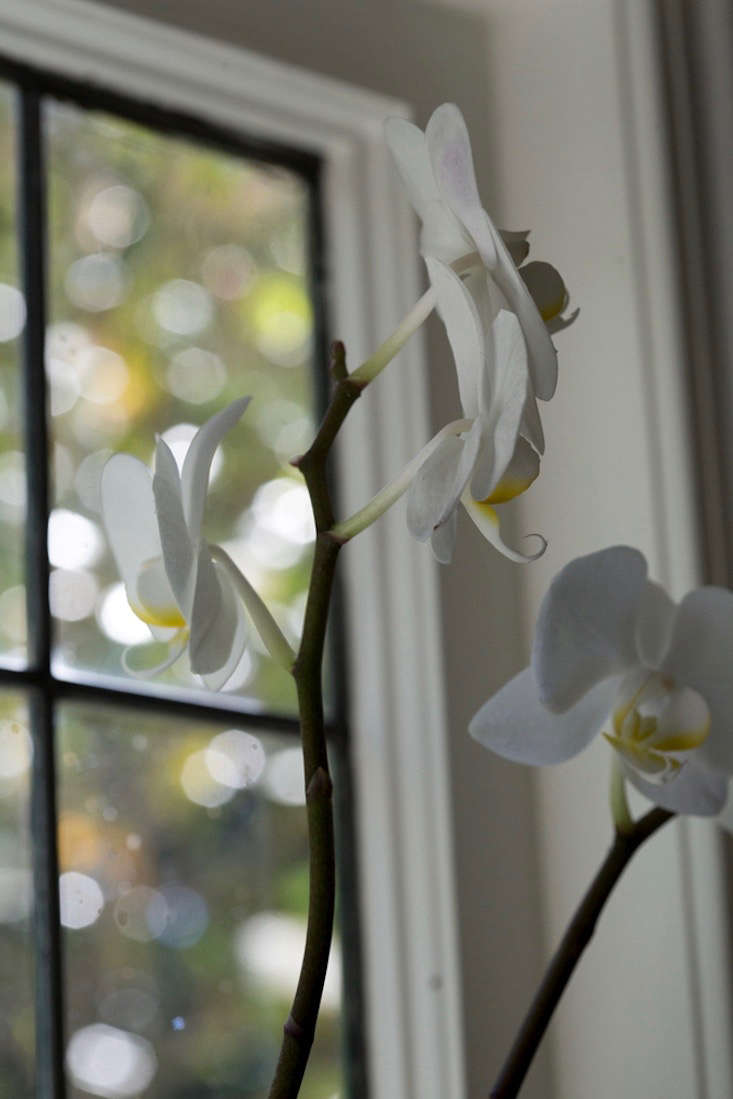You got a moth orchid as a holiday gift. Or as a birthday present. Maybe it came from your grandmother, who also informed you that the plant’s horticultural name is Phalaenopsis and that there are dozens of species. But this is not what concerns you: the problem is the flowers have shriveled, leaving behind a bare spike and a couple of waxy green leaves in a pot. You wonder, “When my orchid bloom again?”
Mary Gerritsen understands your pain. Orchid whisperer Gerritsen coaxes hers to flower again every year—and shares her top plant care tips here.
The author of A Bay Area Guide to Orchids and their Culture has been growing orchids since the 1970s and says: “Most of the indoor orchids I have are ones someone got as gift and the flower fell off and so they said, ‘Here,’ and gave it to me.”
Photography by Mimi Giboin for Gardenista.

What should I do when my orchid stops blooming?
The goal is to get your moth orchid to bloom at least once a year, for several months. (Some of Gerritsen’s will bloom for eight to ten months.)
First, cut off the old flower stalk at the base of the plant. Then put your moth orchid in a room in your house that simulates the conditions that will cause it to flower again. For starters, it will need a month’s worth of daily temperature drops of at least 10 degrees from day to night.
“In your house, you tend not to have big drops; the temperature tends to be set to a steady 68 degrees,” says Mary. So put your orchid in a room that gets a little cold by the window—and put your orchid in the window. When the sun goes down, the heat will drop and the cold will stimulate it to re-bloom.
Tip: “My room has a window that faces south, has no heat vent, and basically has glass on two sides and a skylight, so it gets a temperature spike during the day,” Gerritsen says.

When should I re-pot my orchid?
“Often the ones from the florist have damaged roots,” says Gerritsen. “Make sure it’s not done up as a throwaway, stuffed in a pot with a bunch of pebbles, reindeer moss, and no drainage.”
Tip: Re-pot, after an orchid stops blooming. Take it gently from its pot, shake off the old bark, and cut off any dead roots with a sterile razor blade or scissors. “Don’t make the mistake of putting into a bigger pot, because orchids don’t like that,” says Gerritsen. “They like to have their roots crowded in a small space.” So pot it into a same-size pot, holding its leaves so the roots dangle into the pot. Add bark and gently mix the pieces around its roots to hold them snugly.
Gerritsen recommends a potting medium of Douglas fir bark to aid drainage and air circulation. A 1-gallon bag of Douglas Fir Bark For Orchids is $23.99 from Amazon.

How much sun does a moth orchid need?
Orchids like bright, indirect light. “Most important—no burning hot sun,” says Gerritsen. “Don’t put it in direct sun, which can cook it.”
Tip: North-facing windows tend not to get enough light to satisfy an orchid (“unless the building across the street is white or a shiny material and you get a lot of reflected light,” says Gerritsen).

Should I put my orchid in a Swiss-cheese pot with the holes?
It’s not necessary to use an open-air orchid pot if your plant’s roots have good air circulation in a pot. The Swiss-cheese pots attempt to replicate orchid-growing conditions in the wild, where the plants either grow visibly on the surface of trees (epiphytes with roots attached to the bark of tree branches) or on rocks, with their roots working their way into crevices.
Tip: Give roots lots of air by tucking them into medium-size pieces of bark.

How often should I water my orchid?
“First, you want to be careful when it’s in bloom that the roots have a chance to dry out between waterings,” says Gerritsen. “Don’t let it sit in a bowl of water.”
Tip: Water a Phalaenopsis once a week and let the water run out from its roots so they don’t rot.

Can I take my orchid outdoors in nice weather?
Orchids like the increased air circulation and the temperature change they get outdoors. “Put them in a place where they are not in direct sun, under a tree so they don’t get overheated,” says Gerritsen. “They do very well outside. Bring them indoors for the cool months.”
Tip: Outdoors, pick a protect place where wind won’t blow over your orchid. If you have no shade, buy shade cloth to make a little canopy to protect your orchid from too much sunlight.

For more of our favorite orchids, see:
Finally, get more ideas on how to successfully plant, grow, and care for orchid with our Orchid: A Field Guide.
Finally, get more ideas on how to plant, grow, and care for various houseplants with our Houseplants: A Field Guide.
Interested in other tropical plants for your garden or indoor space? Get more ideas on how to plant, grow, and care for various tropical plants with our Tropical Plants: A Field Guide.
N.B.: This post has been updated with new links and prices; it was first published November 2018.














Have a Question or Comment About This Post?
Join the conversation (1)